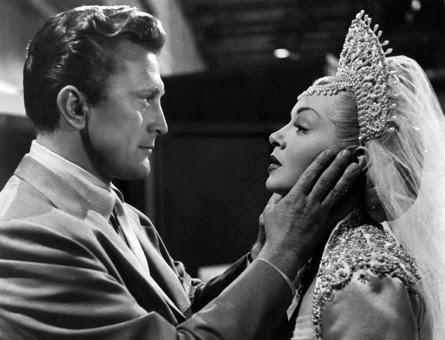
Hollywood films about Hollywood behind the scenes didn’t begin or end with Vincente Minnelli’s The Bad and the Beautiful (1952), but none has painted a more glamorous/gimlet-eyed portrait or better mirrored the town’s notion of itself at a particular moment. It was mid-20th century, just as the old order - the studio system - was about to collapse. David Raksin, composer of the film’s sinuous score, characterized this cinematic self-reflection as “…an affirmative appraisal, one that captures the spirit of the time and place with cunning eloquence; and when it looks at the scars and wrinkles, it is with a lover’s eye. In 1952 we were still infatuated with our little world…”
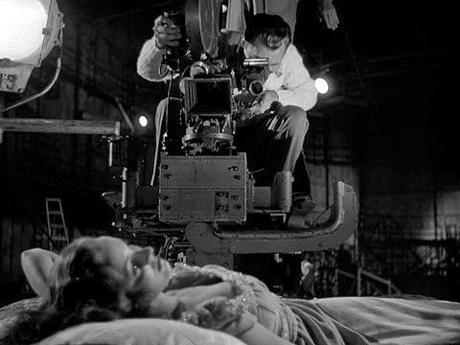
"Some of the best movies are made by people working together who hate each others guts." - Jonathan Shields
A phone rings insistently as Raksin’s brassy, bluesy fanfare begins to recede. Jonathan Shields (Kirk Douglas), formerly a major Hollywood player now relocated in Paris, is reaching out, through a transatlantic operator, to those who were once his closest collaborators, three people he mentored and exploited on his way up. None will listen to him, not his ex-partner, director Fred Amiel (Barry Sullivan), nor his one-time lover, leading lady Georgia Lorrison (Lana Turner), or screenwriter James Lee Bartlow (Dick Powell), the best-selling novelist he brought to Hollywood and befriended.
After a string of box office flops, Shields is down - and in exile - but not quite out. He’s hatched a new idea for a film but, as his aide, Harry Pebbel (Walter Pidgeon), tells all three when they gather in his studio lot office much later that night, “On the name Jonathan Shields, it's impossible to raise five cents, but on Fred Amiel, Georgia Lorrison, James Lee Bartlow, I can raise two million dollars by tomorrow noon.” No one is swayed. But Pebbel goes on, repeating that he knows they’ll never agree to work with Shields again, adding, “You've done enough for him already, then, vice versa maybe."
A series of three individual flashbacks begins with Fred Amiel’s recollection of meeting Jonathan 18 years earlier at the funeral of his father, Hugo Shields, a washed-up movie pioneer. The reminiscences end more recently, when James Lee Bartlow discovered that it was Shields who set in motion events that inadvertently led to the death of his wife. Returning to the present, the transatlantic call connects and Jonathan begins pitching his idea. Though all three stand up and file out of the room, they pause at an extension phone in an outer office and begin to eavesdrop.
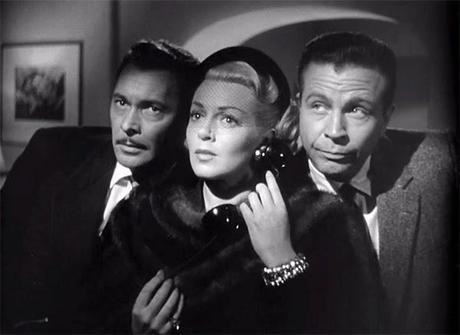
"They're gone. Yeah, I'm sure it's a great idea, but Jonathan..." - Harry Pebbel
When Vincente Minnelli read Charles Schnee’s script, he was taken with the story, observing that “All that one loved and hated about Hollywood was distilled in the screenplay.” He found it “harsh and cynical,” but also "strangely romantic." Lavishly mounted and meticulously detailed, the films of Vincente Minnelli are a testament to his grasp and mastery of mise-en-scène. For The Bad and the Beautiful, he conceived a bustling company town drenched in gloss and deep shadows (courtesy of Robert Surtees). With the story covering a historical period of 18 years as well as depicting on-the-set movie production, 110 sets were used, 10 of them for scenes within scenes.
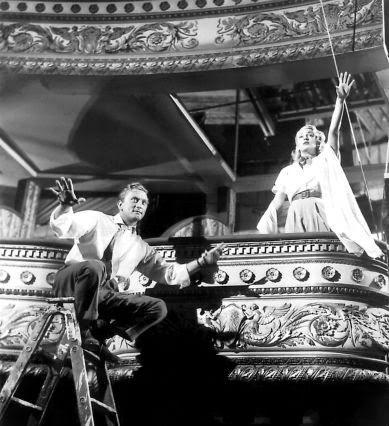
"If you dream, dream big" - Jonathan Shields
An impressive cast was assembled to portray an array of characters meant to intentionally resemble real-life Hollywood movers and shakers. John Houseman later admitted that everyone involved with the project was amused by “so much ‘inside’ material full of private and not so private jokes and references.” Jonathan Shields, the brash “boy genius,” recalls David O. Selznick, whose once enviable movie career had already gone into steep decline, but also nods in the direction of Darryl F. Zanuck, who had decamped to Europe by this time. Georgia Lorrison is loosely modeled on Diana Barrymore, John Barrymore’s wayward daughter. Harry Pebbel may be patterned after MGM exec Harry Rapf. Rosemary Bartlow (Gloria Grahame) bears passing resemblance to F. Scott Fitzgerald’s high-maintenance Southern belle wife, Zelda. Henry Whitfield (Leo G. Carroll) and his assistant (Kathleen Freeman) spoof Alfred and Alma Hitchcock. Even minor incidents suggest real-life events. Minnelli devised a party scene to include a girl (Peggy King) sitting next to the pianist; she is singing a song but no one notices. This bit of business alludes to something Judy Garland was known to do - often - at Hollywood parties. The more climactic scene in which James Lee Bartwell climbs the side of a mountain to the site of the wreckage where his wife’s plane has crashed also echoes history; Clark Gable did the same when his wife Carole Lombard’s plane crashed on a mountainside.
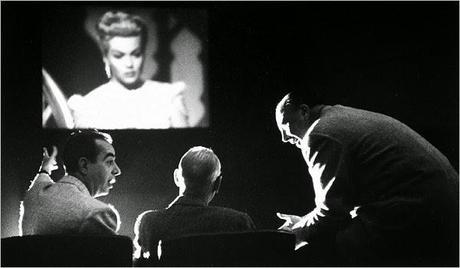
Screening The Bad and the Beautiful: Vincente Minnelli, far left, and John Houseman, far right
According to Houseman, a palpable “atmosphere of success” existed on the set of The Bad and the Beautiful from the day shooting began. Success would follow the film through its previews (only 1 negative review in 160), its premiere and beyond. It would become one of the top grossing films of 1952 and was the year’s big winner on Oscar night, winning five of its six nominations. The awards won were for supporting actress (Gloria Grahame), screenplay (Charles Schnee), cinematography (Robert Surtees), art/set decoration (Cedric Gibbons, et al) and costume design (Helen Rose). Only Kirk Douglas, who was nominated for Best Actor, did not win. Bizarrely, the film was not nominated for Best Picture, the only film to win so many awards and not be nominated for the top prize. Just as odd, neither director Vincente Minnelli nor composer David Raksin garnered nominations. Oscar politics, no doubt, for without Minnelli and Raksin the film would likely possess far more Bad and quite a bit less Beautiful.
Raksin not only composed but also arranged, orchestrated and conducted his score for The Bad and the Beautiful. Early on, when he had completed his composition, he played it on piano for his friend Andre Previn. Previn was puzzled, later writing that when he first heard the tune it seemed to him that “the harmonies tumbled over one another, and the melody was a snake.” When Raksin later presented the piece to Houseman and Minnelli, he took care to play a recording made with a studio orchestra to better convey the full effect of his music. They didn’t know what to make of it but, fortunately for Raksin, Betty Comden and Adoph Green happened to be in the room at the time and both were dazzled (as was Previn when he heard the orchestral version). Houseman and Minnelli instantly came around.

Composer David Raksin
John Houseman had charged Raksin with composing a “siren song,” a theme that would evoke the special charms of Machiavellian Jonathan Shields along with the dissonant allure of Hollywood itself. Raksin reconstructs and repeats his main theme throughout the picture, and the result is endlessly intriguing. Not only is the music a siren song par excellence, but it also underscores and enhances the bittersweet mood of the entire tale as well as each of the three flashback vignettes within it.
There is more to Raksin’s score for The Bad and the Beautiful than its bewitching main theme, and certain of these musical interludes provide a glimpse into the history of movie music. During Fred Amiel’s flashback, the film follows his and Jonathan’s early assignments on quickie Westerns and B-horror fare, and Raksin offers clever takes on the musical cliches of ‘30s cowboy movies and ‘40s horror films (Roy Webb for Val Lewton, in particular). He also crafted an homage to Max Steiner’s Gone with the Wind score during the James Lee Bartwell flashback.
The Bad and the Beautiful ends with a legendary and ambiguous final shot: Amiel, Lorrison and Bartlow listen silently and intently as Jonathan explains his movie concept to Harry Pebbel. This scene leaves it very much to Raksin’s music to indicate an answer to the question the entire audience is mulling at this instant, “Will they work with him again or not?” Raksin thought this a brave gamble on the part of Houseman and Minnelli and considered that this was the moment where the siren song he devised “…either works, or the film ends on an indeterminate note. But together, the image and the music combine to leave us wondering whether the three skeptics are not once again hooked...” Raksin titled this final variation on the main theme "The Spellbinder."
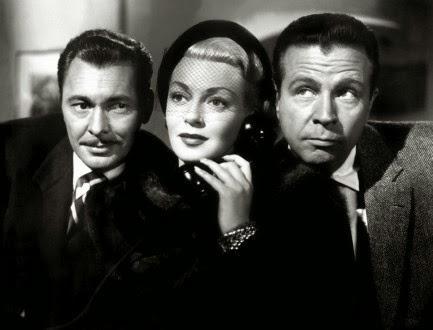
"Look, folks, you've got to give the Devil his due." - Harry Pebbel
David Raksin’s score for the Bad and the Beautiful is one of the most mesmerizing and identifiable movie themes ever. In fact, so intimately intertwined are imagery and music that it's impossible not to be reminded of the score at the mere mention of the movie's title. Raksin scored several other popular films in the course of his long career, including another enduring classic with an equally haunting and recognizable theme, Otto Preminger’s Laura (1944). Raksin was Oscar-nominated for Forever Amber(1944) and Separate Tables (1958), nevertheless, the Academy badly bungled the music category in 1944 and 1952 when it overlooked two film score masterpieces.
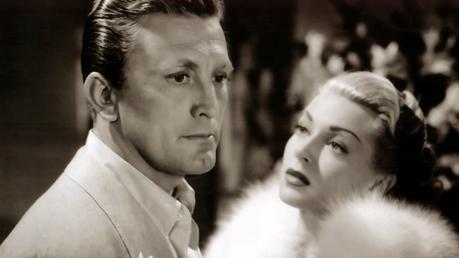
"There are no great men, buster! There's only men." - Lila, bit actress
Georgia Lorrison is one of the two great roles of Lana Turner’s career (the other is Cora in The Postman Always Rings Twice). Under the director’s steady hand (“Minnelli knew exactly what he wanted,” she would remember), Turner gave a fine, emotionally resonant performance as talented, volatile Georgia Lorrison. For the finale of Georgia’s flashback, Minnelli devised a stunning sequence that put an operatic exclamation point to the end of her relationship with Jonathan Shields. Minnelli shot the scene in which Georgia speeds away from Jonathan’s mansion in a rainstorm, growing more hysterical and erratic by the second, in a single take.
The staging for the shot was complicated and took weeks to set up. In the end, a car’s chassis was attached to huge springs fastened onto a plank platform. Some of the crew held buckets of water and hoses to simulate rain, others were assigned to push the planks around and set the car in motion. The camera was positioned on a dolly that would provide enough mobility to capture Georgia’s breakdown from many angles. Lana Turner knew this was her big scene and was surprised when Minnelli, rather than give her specific direction as he normally did, told her, “It’s in your hands.” Drawing on her rocky personal life, at 31 she’d already discarded three husbands and been unceremoniously dumped by Tyrone Power, Turner poured all of it into the scene.
"Someday, you'll learn to love 'em and leave 'em." - Fred Amiel to Jonathan Shields
Kirk Douglas gained a firm foothold on the Hollywood A-list thanks to The Bad and the Beautiful, and there he remained for the better part of the next two decades. He and Minnelli had worked well together (“I was the teacher’s pet,” he told author Mark Griffin 50+ years later) on their first outing and would collaborate on two more films, Lust for Life in 1956 and Two Weeks in Another Town in 1962. Minnelli, Douglas believed, “was a genius and for whatever reason, that has never been properly recognized.”
~
The Classic Film & TV Café is hosting a Build Your Own Blogathon, featuring 20 bloggers whose successively published posts link to the previous participant’s through a common element. My post on The Bad and the Beautiful links to Rick’s post at the Caféon Jubal(1956) through composer David Raksin. Next up is Christian of Silver Screen Modes, who explores Vincente Minnelli’s Lust for Life (1956). Our posts are linked through actor Kirk Douglas.
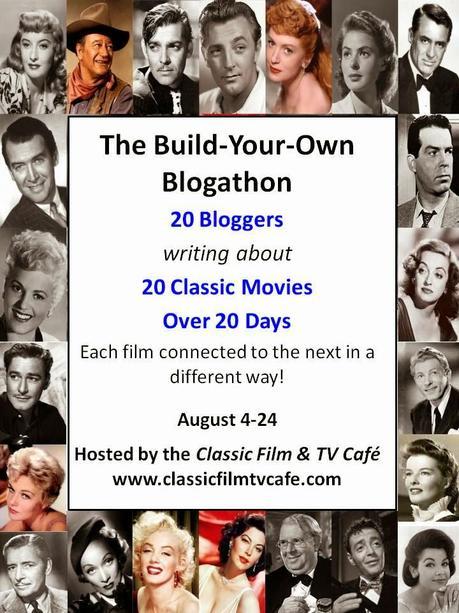
Notes:
The Bad and the Beautiful is included on every list ever compiled of the top movies about Hollywood. It also bears the distinction of being included among Martin Scorsese’s 85 Films You Need to See to Know Anything About Film.
Lana: The Lady, the Legend, the Truth by Lana Turner (E.P. Dutton, 1982)
The Ragman’s Son by Kirk Douglas (Simon and Schuster, 1988)
“The Bad and the Beautiful – Original Motion Picture Soundtrack,” liner notes by David Raksin (MGM/Turner Classic Movies, 1996)
A Hundred or More Hidden Things: The Life and Films of Vincente Minnelli by Mark Griffin (Da Capo Press, 2010)

